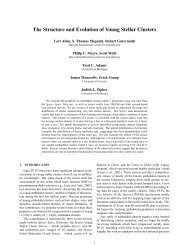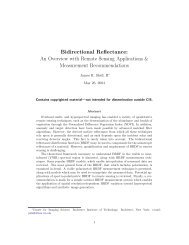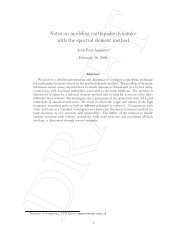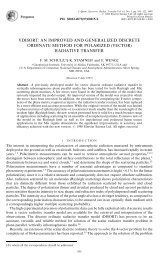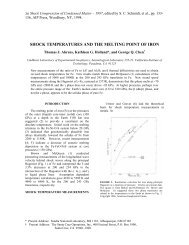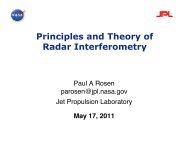VLIDORT User's Guide
VLIDORT User's Guide
VLIDORT User's Guide
Create successful ePaper yourself
Turn your PDF publications into a flip-book with our unique Google optimized e-Paper software.
1. Ross-thin kernel - kernel factor.2. Li-dense kernel - kernel factor.3. Li-dense kernel - kernel parameter #1.4. Li-dense kernel - kernel parameter #2.5. Cox-Munk kernel - kernel factor.6. Cox-Munk kernel - kernel parameter #1.The weighting functions displayed are a result of the following BRDF weightingfunction inputs in the BRDF input configuration file "2p6_BRDF_ReadInput.cfg":<strong>VLIDORT</strong> - Kernels, indices, # pars, Jacobian flagsRoss-thin 2 0 T F F FLi-dense 5 2 T T T FCox-Munk 9 2 T T F FThe second part of the test program is an intensity and surface albedoweighting function calculation done by <strong>VLIDORT</strong>.There are 6 NORMALIZED surface weighting functions calculated:1. w.r.t. Ross-thin kernel - kernel factor.2. w.r.t. Li-dense kernel - kernel factor.3. w.r.t. Li-dense kernel - kernel parameter #1.4. w.r.t. Li-dense kernel - kernel parameter #2.5. w.r.t. Cox-Munk kernel - kernel factor.6. w.r.t. Cox-Munk kernel - kernel parameter #1.We are using the in/outgoing single-scatter correction with delta-M scaling(this is a standard default, and the most accurate calculation).The first call is the baseline calculation of intensity and all 6 surfaceJacobians. The threads are designed to test Jacobians by finite differencing.They are:Thread 1: Finite difference, perturb Ross-thin kernel - kernel factor.Thread 2: Finite difference, perturb Li-dense kernel - kernel factor.Thread 3: Finite difference, perturb Li-dense kernel - kernel parameter #1.Thread 4: Finite difference, perturb Li-dense kernel - kernel parameter #2.Thread 5: Finite difference, perturb Cox-Munk kernel - kernel factor.Thread 6: Finite difference, perturb Cox-Munk kernel - kernel parameter #1.The output file contains (for all 36 geometries and 5 output levels) thebaseline intensities, baseline Analytic weighting functions (AJ1, AJ2 etc.),and the corresponding finite difference weighting functions (FD1, FD2 etc ).The integrated output (actinic and regular fluxes) are output for all SZAs andall 5 output levels.6.2.2. Programs for <strong>VLIDORT</strong> vector testsSince the five vector tests are very similar to the scalar tests above, a detailed description of eachtest will not be repeated here; however, we make a few comments regarding these inputs.In these tests, the main difference is a more sophisticated treatment of aerosol in the bottom sixlayers. Here, expansion coefficients for the Greek scattering matrix were generated by a Miescattering code and are read in from the input file ProblemIII.Moms. [Mie results were generated103



